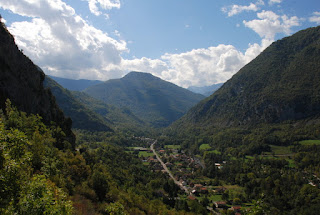We were ready too early for the museum so we took a stroll
around the walls of Lectoure admiring the magnificent views that there would
have been if there hadn’t been for the thick mist that meant that we couldn’t
even see the bottom of the hill. We arrived at the museum at 10:10 to see a
sign that said that the next visit to the museum was 15:00. The original notice
did not make it clear that it was a guided tour at 10:00 and, if you missed
that one then you had to wait until the afternoon. Very disappointed, we had to
leave without visiting the museum. However Lectoure is a lovely place and we
would definitely like to return, stay in the aire again and visit the museum
precisely at 10:00.
Leaving earlier than intended, we were able to plot a route
via a number of places of interest, the first of which was the Gorge de la Save
and a Roman Villa, both close to Montmaurin in the Haute-Garonne. This is the
department of the Mid-Pyrenees and the terrain became much hillier with the
foothills of the Pyrenees in the distance. We followed signs to gorge only to
find a barrier blocking the road. We followed a circuitous route to get close
to the other end of the gorge and in Montmaurin we saw signs to an orientation
table. Following the signs, in a few metres we came to a small parking place
next to a picnic table and the orientation table. There in front of us was our
first view of the mountains of the Pyrenees, very hazy but we could pick out
many jagged peaks including the massive Pic de Casamanya (2740m) in Andorra.
The sun was shining brightly and it was lunchtime, so we sat at the picnic
table eating Camembert and French bread looking out at the panorama of the
Pyrenees.
Following new signs to the Gorge de la Save we reached the
other end of the barred road, parked up and walked into the gorge. As far as we
could ascertain, the road closure was as recent as July this year and had been
done due to the risk of rock and tree falls. However, it was open to
pedestrians and we had it to ourselves – very peaceful with the sound of
birdsong and the babbling stream. The limestone gorge is full of caves and
provides a very pretty walk.
On then to the Roman Villa less than a mile away.
Unfortunately, as we expected, the villa was closed as it was a Monday and many
historical sites and museums are closed on Mondays.
Every Wednesday when I am at home I volunteer for Hands on
Heritage at the Avalon Marshes Centre on the Somerset Levels. The volunteers,
led by two professional archaeologists, are helping to build a reconstruction
of part of a Roman Villa and an Iron Age Long House. We take part in all sorts
of activities including pottery, woodwork (doors, furniture, wooden roof tiles
etc.) and building cob walls. Before I joined, the group made two excellent
replicas of Iron Age canoes based on one found in the lake villages near
Glastonbury. The members of the group are great company and one of the most
enthusiastic is Lucy who has renamed the group as ‘Axe Club’. I knew that Lucy
had been brought up in France but during a recent chat I discovered that she
lived in the Mid-Pyrenees in the area of Ariege. As we going to be travelling
near that area, I asked Lucy to recommend some points of interest and one of
them was the village of Montbrun Bocage. That was our next stop and a
fascinating village it is. Definitely Mediaeval and with many characterful buildings
and a lovely market square, we spent a most enjoyable hour wandering around it’s
streets and up to the ruins of its castle / chateau shrouded in trees.
Next on the agenda was the Mas D’Azil, an enormous natural
cave with a road running through it. It is so big that it was used in WWII to
house an aircraft factory out of sight of enemy bombers. In the middle of the
cave is the entrance to the show cave, although this is mostly about
prehistoric occupation rather than stalagmites and stalactites. It was too late
to visit the caves (and we had other plans) but it was fun to drive through and
we stopped in the car park at the southern end so that we could walk into the
cave to have a closer look.
On then just a few miles to the aire at Castelnau Durban,
our stop for the night. Confusingly, when we arrived there were quite a few
motorhomes parked in the car park that specifically stated that they were not
allowed. We drove on another 100m to the designated aire and parked up with one
other motorhome. Having settled in, it was twenty minutes later when we discovered
why other motorhomers had parked elsewhere. We were directly opposite a church
that had a bell mounted on its roof and on the hour it rang extremely loudly.
As if that wasn’t enough, it was one of those clocks that we had occasionally encountered
before, it chimed the hours twice!
Photos: The walls of Lectoure in the mist; The Gorge de la
Save; One of it’s many caves; The market square of Montbrun Bocage; Montbrun
Bocage houses; Montbrun Bocage shops; The southern end of the Mas D’Azil cave;
The interior of the cave with the road running through.
























